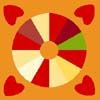![]()
![]()
![]()
Use LEFT and RIGHT arrow keys to navigate between flashcards;
Use UP and DOWN arrow keys to flip the card;
H to show hint;
A reads text to speech;
11 Cards in this Set
- Front
- Back
- 3rd side (hint)
|
What is the Dresden Plate Quilt Exhibit?
|
This is an exhibit from the Museum of the American Quilters Society. Each year the museum sponsors a contest asking quilters to make a piece using innovative quilting techniques, but based on a traditional design. This exhibit is composed of the 2006 winning quilts based on a dresden plate quilt block.
SOURCE: Dresden Plate Exhibition Catalog |
|
|
|
What is Dresden Plate?
|
Dresden Plate is a popular quilt block pattern from the 1930's and 40's. The blocks feature a circle of blades with rounded tips. Dresden Plate was and is a popular patten becuase it is easy to make make with fabric scraps. During the Great Depression quilters would use scraps from brightly colored, printed feedsacks to make Dresden Plate quilts.
SOURCE: Dresden Plate Exhibition Catalog |
|
|
|
1st Place Quilt: "Can You Feel The Spirit" by Cathy Pilcher Sperry
|
Sperry is homemaker from Cincinnati, OH. She began quilting in 1985 when she moved to New Jersey and was looking for a way to make new friends. The inspiration for this quilt came from a the first quilt her grandmother made, which was Dresden Plate. Her grandmother's quilt reminded her of daisies so when she found the daisy batik fabric she was inspired. Value contrast and dimension are important in this design becuase they create the illusion of depth and movement.
SOURCE: Dresden Plate Exhibition Catalog |
|
|
|
2nd Place Quilt: "Reinventing the Wheel" by Sherri Bain Driver
|
Driver, of Tuscon, AZ, grew up in a family of sewers and designers. She followed in the family footsteps by combining these two passions in her quilting. This quilt is the result of Driver's desire to use a variety of fabrics in her quilt. She was intrigued by another quilt style, Card Trick, which features overlapping blocks. Driver used this overlapping technique to combine 4 Drseden Plate blocks to make this quilt.
SOURCE: Dresden Plate Exhibition Catalog |
|
|
|
3rd Place Quilt "Paisley Pavane" by Nadine Ruggles
|
Ruggles, of Gerlingen Germany, is such an enthusiastic quilter that she started far more projects than she finished. As she was working on finishing some of these long forgotten pieces, she discovered two of the round medallions and knew they were perfect for the contest quilt.
SOURCE: Dresden Plate Exhibition Catalog |
|
|
|
Fast Fact
|
Three of the quilters featured in this exhibit-- Julia Graber, Polly Yoder, and Barbara Cline are all sisters.
|
|
|
|
4th Place Quilt "A Plate of Pineapples" by Julia Graber
|
Julia Graber was inspired to make quilts in her 20s when she worked in her parents' fabric shop. In this piece she uses bold color and value to enhance further the intricate design.
SOURCE: Dresden Plate Exhibition Catalog |
|
|
|
5th Place Quilt: "The Dazzling Dresden Doodle" by Polly Yoder
|
Polly Yoder began quilting with members of her family. She always had a habit of doodling ribbons while talking on the phone, and these doodles worked themselves into designs for quilts. Her daughter encouraged her to use this design in particular for the contest, which Polly says "took her out of her comfort zone" with the intricate techniques and planning.
SOURCE: Dresden Plate Exhibition Catalog |
|
|
|
How can I learn more about the quilting contest?
|
The contest is sponsored by the Museum of American Quilter's Society in Paducah, KY. The 2007 contest is already complete, but the 2008 theme is sawtooth and applications are available on the museum's website: http://www.quiltmuseum.org
|
|
|
|
Many of the quilters in this exhibit use it as a social experience. How can I find a quilting group?
|
You can find a local quilting group by visitng www.quiltguilds.com. This website lists 18 Louisiana quilt guilds, including groups in Lafayette, Lake Charles, Alexandria, and Baton Rouge.
|
|
|

History of the Dresden plate design
|

The name, Dresden Plate, started in the late 1920s, but ther were precusors to it in fan patterns of the late 1800s, where four fans were pieced into a circle. In 1785, Anna Tuels mother created the earliest known configuration of this design in Anna's wedding quilt.
|
source: http://www.patternsfromhistory.com/colonial_revival/dresden-plate.htm
|

